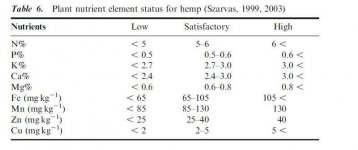maryanne3087
Active member
I'd assume you would need some tools used by analytic chemists to assess what nutrients have been removed by the plants in what quantities.
One thing that could work but is a rather "crude" experiment is adding back nutrient solution and maintaining the same pH and concentration. When you get deficiencies you know you're not using enough of whatever element, when you get burn you know you're using too much of whatever element. If you never get deficiencies or burn with say a given formulation of say the 3:2:1 mix ratios you know you're fairly close to what the plant needs!
One thing that could work but is a rather "crude" experiment is adding back nutrient solution and maintaining the same pH and concentration. When you get deficiencies you know you're not using enough of whatever element, when you get burn you know you're using too much of whatever element. If you never get deficiencies or burn with say a given formulation of say the 3:2:1 mix ratios you know you're fairly close to what the plant needs!





